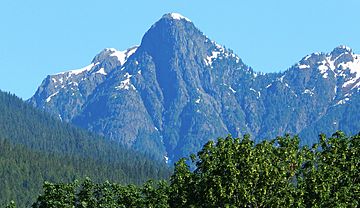Diobsud Buttes facts for kids
Quick facts for kids Diobsud Buttes |
|
|---|---|

Diobsud Buttes seen from North Cascades Highway
|
|
| Highest point | |
| Elevation | 5,892 ft (1,796 m) |
| Prominence | 852 ft (260 m) |
| Geography | |
| Parent range | Cascade Range |
| Topo map | USGS Marblemount |
| Climbing | |
| Easiest route | Scrambling |
Diobsud Buttes are a group of mountain peaks in the North Cascades mountain range. They are found in Skagit County, Washington state, in the U.S.. These peaks are north of Marblemount, Washington and Helen Buttes. They are part of the Noisy-Diobsud Wilderness area. This land is managed by the Mount Baker-Snoqualmie National Forest. The closest taller peak is Logger Butte, which is about 1.4 kilometers (0.85 miles) north. Water from Diobsud Buttes flows into the Skagit River.
Weather at Diobsud Buttes
Diobsud Buttes is in a special climate zone called the marine west coast climate. This means it gets a lot of moisture from the Pacific Ocean. Most weather systems come from the Pacific and move northeast. When these weather systems reach the Cascade Mountains, the tall peaks force the air upwards. This causes the air to cool and drop its moisture as rain or snow.
Because of this, the western side of the North Cascades gets a lot of rain and snow. This is especially true during the winter months. The climate is mild because it's close to the ocean. Temperatures rarely go below -18°C (0°F) or above 27°C (80°F). Winters are often cloudy, but summers usually have clear skies. The snow here tends to be wet and heavy. This can sometimes lead to a high risk of avalanches.
How Diobsud Buttes Formed
The North Cascades mountains have very rugged and dramatic landscapes. You can see sharp peaks, long ridges, and deep valleys carved by glaciers. These amazing shapes were created by geological events that happened millions of years ago. These events caused huge changes in elevation and led to different climates in the area. These climate differences also created many different types of plants and ecosystems.
The Cascade Mountains started forming millions of years ago, during the late Eocene Epoch. This happened because the North American Plate was slowly moving over the Pacific Plate. This movement caused a lot of volcanic activity. Also, small pieces of the Earth's crust, called terranes, came together. This process helped create the North Cascades about 50 million years ago.
Over two million years ago, during the Pleistocene period, glaciers played a big role. Huge sheets of ice moved across the land many times. As they moved, they scraped away rock and left behind debris. This is why many river valleys in the area have a "U" shape. The main forces that created the tall peaks and deep valleys of the North Cascades were uplift (when land pushes upwards) and faulting (when cracks form in the Earth's crust), combined with the action of glaciers.
Images for kids
- Diobsud Buttes weather forecast




